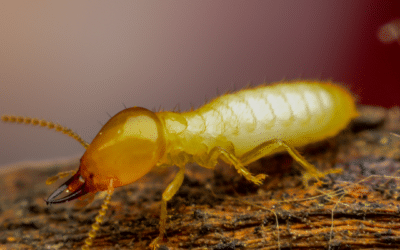Termites are found throughout Texas when temperatures are higher and humidity is greater. The most common types of termite found in the Waco, Temple, and Killeen areas are the Subterranean termite, Drywood termite, Dampwood termite, and Formosan termite.
This article provides in-depth information about each common termite species in Texas and answers these questions: What do termites look like and how can you identify the different species? How do you know if you have a termite infestation? What are the signs of termite damage?
What do termites look like?
All termites share some common characteristics, such as their small size and pale bodies. However, there are also some distinct differences between these types that can help you identify them. Read on to learn more about these different types of termites.
Subterranean Termite
One of the most common types of termite in our area is the Subterranean termite. Subterranean termites live in underground colonies and build tunnels and mounds above ground. They feed on wood and can quickly cause severe damage to homes and other structures.
The swarmer type has a dark brown to black coloration and tiny pairs of wings approximately a quarter- to half-inch long. The worker variety is white and around a quarter of an inch in length or less. Soldier termites are easily identified by their massive jaws, creamy-white coloring, and brownish heads.
Drywood Termites
Drywood termites typically live in warm, dry climates, and like other termites, they eat wood and damage buildings.
The reproductive termites of this species are identified by their dark brown bodies and grayish-black wings and measure half an inch long. The brown-colored head of the soldier class can be recognized by its large mouth parts that extend out beyond the head.
Dampwood Termites
Dampwood termites typically live in moist, humid environments. They infest the wood they feed on, threatening homes and other structures.
Dampwood termites are known to emit a distinctively noxious odor. They can grow up to almost an inch long, bigger than the Drywood and Subterranean types. Swarmer season generally occurs from May to September.
You can identify these swarmers by their dark brown bodies and wings. Their soldiers are brown or yellowish in hue, with antennae on either side of their heads. Nymphs are easy to identify because of their creamy color and spotted abdomens.
Formosan Termites
Formosan termites are considered the most destructive type of termite and can devour the structure of a home quickly, and because of their large colonies, they are hard to eradicate.
The Formosan termite swarmers are yellowish or golden-brown and about a half-inch long. They gather in large quantities at night in late May and early June, drawn to lights. They have a thick covering of hair on their translucent wings.
It can sometimes be hard to distinguish Formosan termites from the Drywood species. Because Formosan termites are so aggressive in their destruction, it’s best to call a professional when in doubt.
How do you know if you have a termite infestation?
If you think you may have termites, there are a few things you can look for. Termites leave behind small piles of sawdust, called frass. You may also see small holes in wood or wings around your home.
If you see any of these signs, it’s essential to contact a pest control professional to have your home inspected for termite infestation.
What are the signs of termite damage?
Damage can be difficult to spot, as the insect’s damage from the inside out. However, there are a few signs that you may have termites:
- Small piles of sawdust around your home
- Holes in wood
- Wings around your home
- Cracks in paint or wallpaper
- Sagging floors or ceilings
If you think you may have termites, don’t wait until it’s too late to save your home. Instead, call the experts at 855Bugs to schedule a free inspection and stop termite damage in its tracks!




